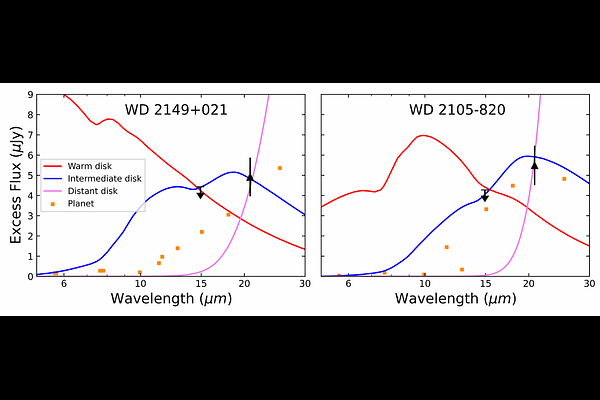Metal Polluted White Dwarfs with 21 μm IR excesses from JWST/MIRI: Planets or Dust?

Metal Polluted White Dwarfs with 21 μm IR excesses from JWST/MIRI: Planets or Dust?
John H. Debes, Sabrina Poulsen, Ashley Messier, Susan E. Mullally, Katherine Thibault, Loïc Albert, Misty Cracraft, Érika Le Bourdais, Patrick Dufour, Tom Barclay, J. J. Hermes, Mukremin Kilic, David Lafrenière, Fergal Mullally, William Reach, Elisa Quintana
AbstractWhite dwarfs with metal pollution are caused by the accretion of rocky dust from tidally disrupted minor bodies and are signposts for planetary systems. These minor bodies are perturbed by planets that have survived post-main sequence evolution. Open questions exist as to the typical mass of the perturbers and the specific planetary architectures that cause metal pollution. JWST's sensitivity in the mid-IR has opened new doors to deciphering polluted white dwarfs. We present JWST Cycle 1 MIRI imaging of four nearby metal-polluted white dwarfs with the goal of detecting and characterizing planetary companions. With deep mid-IR imaging we are sensitive to cold Jupiter-mass planet analogs. In addition to finding two candidate planetary companions, for the first time we detect significant excesses above the expected photospheric emission at 21~$\mu$m for two of our targets, WD 2149+021 and WD 2105-820. WD 2105-280 has a candidate planetary companion at a projected separation of 34 au and an infrared excess--if both candidates are confirmed, it would represent the first WD multi-planet system. We investigate whether these excesses could be caused by very low luminosity warm dust disks or planets. While both are likely, we argue that the most likely explanation for the excesses is that they are the thermal emission from jovian-mass planets in orbits with semi-major axes $<$10 au, using a combination of observational constraints. If most of the candidate planets presented here are confirmed, it would suggest that metal polluted white dwarfs are frequently orbited by at least one giant planet.